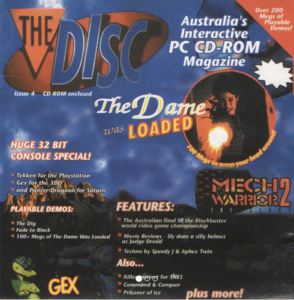Stephanie Harkin
“It’s about time my PC spoke with an Aussie accent!”
For a brief stint in 1995 Melbourne-based studio Beam Software brought the first interactive CD-ROM gaming magazine to Australia. The magazine was called The Disc and could be purchased behind the counter at local news agents. Unlike traditional print magazines, the CD-ROM format brought content to life with video clips, music, voice-overs and playable demos.
The magazine was conceptualised by Beam founder Alfred Milgrom and edited by Steve Polak. Beam employees Cameron Brown and Shane Collier were the presenters, appearing between segments in Full Motion Video (FMV) to introduce content and deliver short, daggy comedy quips.
As Beam writer and designer, Pauli Kidd recalls, “Shane and Cam were the presenters of it being the most outlandishly appearance people in the area. But also great speakers and really engaging characters. They were the face of the Disc magazine *chuckles.*”
CD-ROM was a new and exciting technology because it offered a new standard of high storage capacity. The added storage allowed space for improved-quality audio tracks and FMV footage to be integrated into videogames. While other CD-ROM magazines like Blender and Interactive Entertainment were already drawing attention overseas, Milgom saw an opportunity for an Australian gaming magazine that would likewise take on the multimedia possibilities of this new technology. A 1995 review in The Age praised The Disc as “impressive” and “daring.” [1]
The magazine, however, only published seven issues over seven months. But navigating the magazine’s content today offers a wonderful window into Australia’s multimedia dreams in the 1990s.
Australian music to funding advice: The Disc was more than a gaming news outlet
Beam Software were behind major games like The Hobbit (1982), Shadowrun (1993) and The Dame was Loaded (1995). The Dame was Loaded fully utilised the CD-ROM technology, using Australian actors for its FMV content. Released shortly before The Dame was Loaded, Beam Software embraced The Disc magazine as an opportunity to advertise their upcoming game. Issue #3 included a trailer as well as an overview of how Phillips were successfully courted and convinced to publish the game, while issue #4 proudly featured The Dame was Loaded on its cover and offered a playable demo.
The game demos, trailers and video reviews elevated The Disc from print gaming magazines. This was a specific point of praise in one of The Disc’s fan letters, where the writer was thrilled to be able to “SEE” the games previewed.
The Disc also featured traditional magazine content, like text-based fan letters, “tips and tactics,” top of the charts, giveaways, local classifieds, and news articles. The text-based articles were mixed in with video-format articles and were often broken into “general news” and “multimedia news.” General news covered updates on videogames, game expos and championships, but also offered guides on using Windows 95 and the internet more generally.
The games articles ranged from national content, like a preview of the “Blockbuster Championships” held across the nation at Blockbuster video stores, as well as international news like a behind the scenes preview of Wing Commander IV—an FMV game starring Mark Hamill.

The multimedia news section extensively covered Australian policy developments, support initiatives and funding opportunities for multimedia projects. This section included a serialised advice column and a Multimedia Registry. The registry offered detailed support and contact information for developers, publishers, graphic artists and more.
These sections highlighted the Australian government’s interest in new multimedia industries (which were undefined at the time). The Keating government’s Creative Nation Policy established the Australian Multimedia Enterprise (AME), where Beam founder Alfred Milgrom was appointed to the inaugural board. Milgrom oversaw more than half of the $84 million investment to support multimedia creative industries in developing new technologies and new kinds of creative content—The Disc itself meeting the new multimedia criteria.
Further venturing beyond gaming, The Disc also reviewed music and film with attached audio and video. While most of these were popular international albums and movies, the magazine made an effort to promote Australian artists—e.g. A.K. Soul’s music video “I Like It” was featured in issue #4.
There were also other technical and multimedia demos and reviews. A program called “Cthugha” for instance was featured, which processed audio input into images. Users plugged their CD players into their PC’s audio input and would then watch their music transform into surreal graphics. Another multimedia product was “Eyewitness History,” an interactive encyclopedia on world history and representative of multimedia “edutainment.”
The Disc, while grounded primarily as a gaming magazine, was therefore also a guide into the broader media possibilities available online and through CD-ROM technology, while acting itself as an expression of those possibilities. It mirrored many CD-ROM games that used its storage size as a selling point (like Sierra On-Line’s touted 7 discs for their game Phantasmagoria). The cover of their issues would boast phrases like, “Over 200 Megs of Playable Demos!”
It’s incorporation of FMV for the hosted segments, though, truly embrace the CD-ROM’s capabilities. Brown and Collier pop up to introduce content and crack jokes in front of video clips or pre-rendered backgrounds, previewing the FMV effects that Beam Software would go on to incorporate in The Dame was Loaded.
Centring Australian content
The Disc offers an informative window into Australia’s role in 1990s videogame development and multimedia technology. As mentioned above, its Multimedia Registry speaks directly to the national industry and highlights the Australian government’s interest in supporting creative developments.
The Disc also offered direct advice to smaller developers of games and multimedia in Australia. An article “Exporting Multimedia Services” shows how Australian developers can take advantage of international publishers looking to outsource, arguing that international partnerships were crucial for success.
The article goes on to speculate about Australia’s cultural aversion to self-aggrandisement. Whether this was the case or not for developers in the 90s is disputable, although the discussion sets up a context for telling the story of Beam Software’s own acquisition of international partnerships as a process that others might follow. Other articles provide generalised advice and tutorials for hobbyists and aspiring developers.
The extensive outline of government support options and the advice in these articles all point towards a hopeful imagining of Australia becoming leaders in multimedia production. An interview with at-the-time head of AME, Martin Cooper—presented on The Disc via interactive question and answer audio links—outlines that Australia’s multimedia landscape mostly resided within training and information programs in the mid-90s, with a lesser emphasis on entertainment and videogames.
In the interview Cooper correctly predicts, however, that the platform for these kinds of projects would eventually shift from CD-ROM to internet web browsers.
The Disc certainly celebrates what hosts Brown and Collier call the “huge wads of government cash” flowing into Australia’s multimedia industry, though at the same time the magazine doesn’t shy away from also critiquing government policy. There’s discontent directed at the Office of Film and Literature Classification (OFLC, now the Australian Classification Board) for their exclusion of an R18+ classification for videogames – which wouldn’t come into effect until 2013. The Disc‘s critiques were likely in response to Sierra On-Line’s FMV horror game Phantasmagoria being refused classification at the time, and hence denied a release in Australia. The Disc even urges readers to contact the OFLC to request for the rating’s addition and provides the office’s contact details.
These Australian-specific features of the magazine were praised by its readers. In the magazine’s letters section, one reader expresses their delight “at last” for The Disc’s emphasis on local content and information. Their relief is in light of no longer having to consume previews for products unavailable in Australia from international gaming magazines. Another letter more simply states, “It’s about time my PC spoke with an Aussie accent!”
On Beam Software’s now obsolete website – accessed via web archive – there is a dedicated entry for The Disc. The page says that the magazine, despite receiving critical acclaim, only lasted seven issues because “it seems the market wasn’t quite ready for a CD only format.”[2] As Cooper predicted, such uses of CD-ROM technology would indeed eventually be relocated to the internet.
Notes
1. Perkins, Lee. 1995, June 22. “’The Disc’ goes where few fear to tread.” The Age, p. 32.
.http://web.archive.org/web/19980521013208/http://www.beam.com.au/beam/cgi-bin/gamelist?GAMENAME=thedisc





